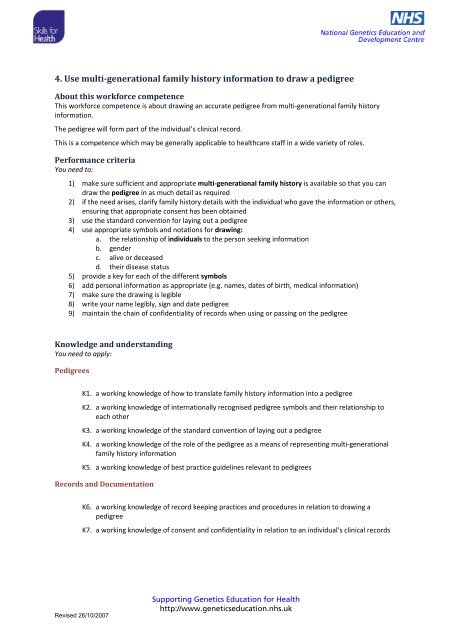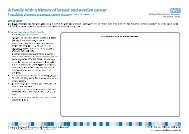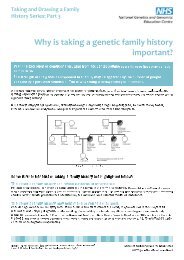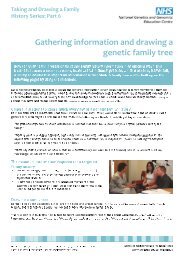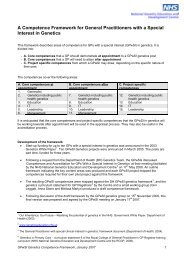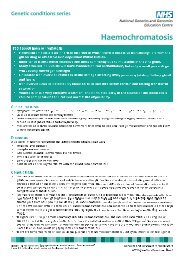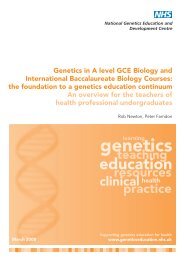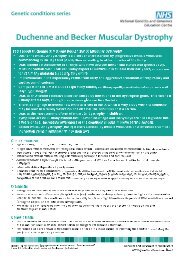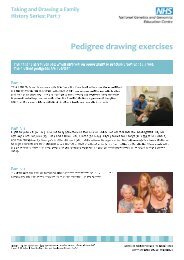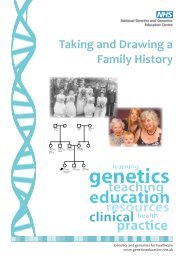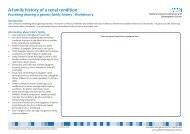Use multi-generational family history information to draw a pedigree
Use multi-generational family history information to draw a pedigree
Use multi-generational family history information to draw a pedigree
Create successful ePaper yourself
Turn your PDF publications into a flip-book with our unique Google optimized e-Paper software.
4. <strong>Use</strong> <strong>multi</strong><strong>generational</strong> <strong>family</strong> <strong>his<strong>to</strong>ry</strong> <strong>information</strong> <strong>to</strong> <strong>draw</strong> a <strong>pedigree</strong>About this workforce competenceThis workforce competence is about <strong>draw</strong>ing an accurate <strong>pedigree</strong> from <strong>multi</strong>‐<strong>generational</strong> <strong>family</strong> <strong>his<strong>to</strong>ry</strong><strong>information</strong>.The <strong>pedigree</strong> will form part of the individual’s clinical record.This is a competence which may be generally applicable <strong>to</strong> healthcare staff in a wide variety of roles.Performance criteriaYou need <strong>to</strong>:1) make sure sufficient and appropriate <strong>multi</strong>‐<strong>generational</strong> <strong>family</strong> <strong>his<strong>to</strong>ry</strong> is available so that you can<strong>draw</strong> the <strong>pedigree</strong> in as much detail as required2) if the need arises, clarify <strong>family</strong> <strong>his<strong>to</strong>ry</strong> details with the individual who gave the <strong>information</strong> or others,ensuring that appropriate consent has been obtained3) use the standard convention for laying out a <strong>pedigree</strong>4) use appropriate symbols and notations for <strong>draw</strong>ing:a. the relationship of individuals <strong>to</strong> the person seeking <strong>information</strong>b. genderc. alive or deceasedd. their disease status5) provide a key for each of the different symbols6) add personal <strong>information</strong> as appropriate (e.g. names, dates of birth, medical <strong>information</strong>)7) make sure the <strong>draw</strong>ing is legible8) write your name legibly, sign and date <strong>pedigree</strong>9) maintain the chain of confidentiality of records when using or passing on the <strong>pedigree</strong>Knowledge and understandingYou need <strong>to</strong> apply:PedigreesK1. a working knowledge of how <strong>to</strong> translate <strong>family</strong> <strong>his<strong>to</strong>ry</strong> <strong>information</strong> in<strong>to</strong> a <strong>pedigree</strong>K2. a working knowledge of internationally recognised <strong>pedigree</strong> symbols and their relationship <strong>to</strong>each otherK3. a working knowledge of the standard convention of laying out a <strong>pedigree</strong>K4. a working knowledge of the role of the <strong>pedigree</strong> as a means of representing <strong>multi</strong>‐<strong>generational</strong><strong>family</strong> <strong>his<strong>to</strong>ry</strong> <strong>information</strong>K5. a working knowledge of best practice guidelines relevant <strong>to</strong> <strong>pedigree</strong>sRecords and DocumentationK6. a working knowledge of record keeping practices and procedures in relation <strong>to</strong> <strong>draw</strong>ing a<strong>pedigree</strong>K7. a working knowledge of consent and confidentiality in relation <strong>to</strong> an individual’s clinical recordsRevised 26/10/2007Supporting Genetics Education for Healthhttp://www.geneticseducation.nhs.uk
LinksThis workforce competence has indicative links with the following dimensions and levels within the NHSKnowledge and Skills Framework (Oc<strong>to</strong>ber 2004).Dimension: HWB2 Assessment and care planning <strong>to</strong> meet health and well‐being needsLevel: 4Dimension: IK2 Information collection and analysisLevel: 2Searchable key wordsGenes, genetic, <strong>family</strong> <strong>his<strong>to</strong>ry</strong>, medical <strong>his<strong>to</strong>ry</strong>, <strong>pedigree</strong>, chromosomes, <strong>family</strong> tree.OriginThis workforce competence has been developed by Skills for Health with the NHS National Genetics Educationand Development Centre Oc<strong>to</strong>ber 2006.GlossaryThis section provides explanations and definitions of the terms used in this workforce competence. Incompetences, it is quite common <strong>to</strong> find words or phrases used which you will be familiar with, but which, inthe detail of the competence, may be used in a very particular way.Multi‐<strong>generational</strong> Family <strong>his<strong>to</strong>ry</strong>IndividualsPedigreeEncompasses three generations of <strong>family</strong> <strong>his<strong>to</strong>ry</strong>, however,where there are existing indications of a particular geneticcondition this may be targeted more specifically.Any adult, child or baby ‐ alive or deceased. In the contex<strong>to</strong>f this competence pregnancies and pregnancy losseswould also be relevant.A graphical representation of genetic relationships andmedical conditions in a <strong>family</strong>.SymbolsBest practice recommends that the symbols <strong>draw</strong>n arethose recognised by the Pedigree Standardisation TaskForce, however, your organisation may utilise othersymbols or methodologies.ScopeThis section provides guidance on possible areas <strong>to</strong> be covered in this workforce competence.DrawingMay include using:a) free‐handb) stencil templatec) pre‐printed materialsd) computer softwareRevised 26/10/2007Supporting Genetics Education for Healthhttp://www.geneticseducation.nhs.uk


